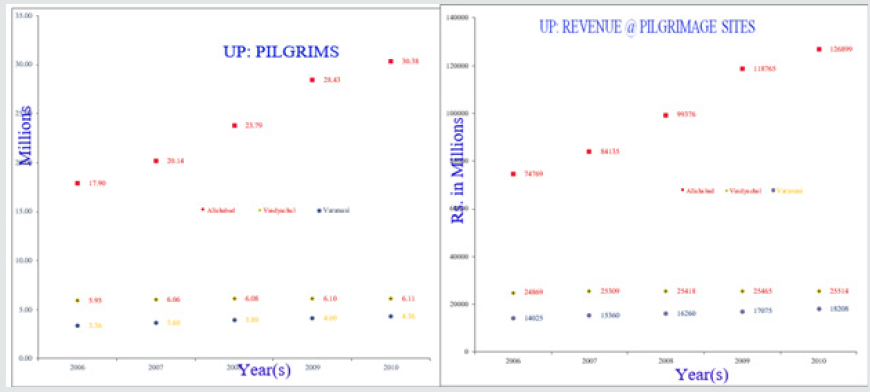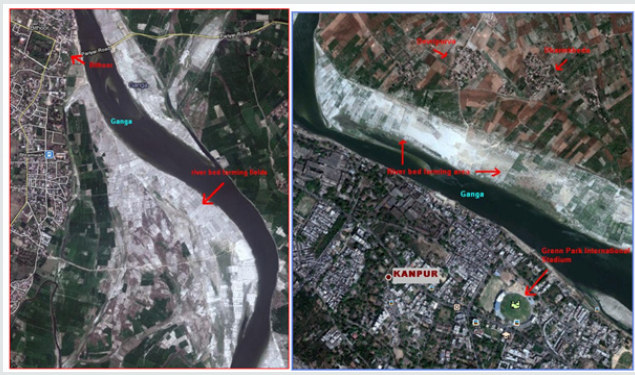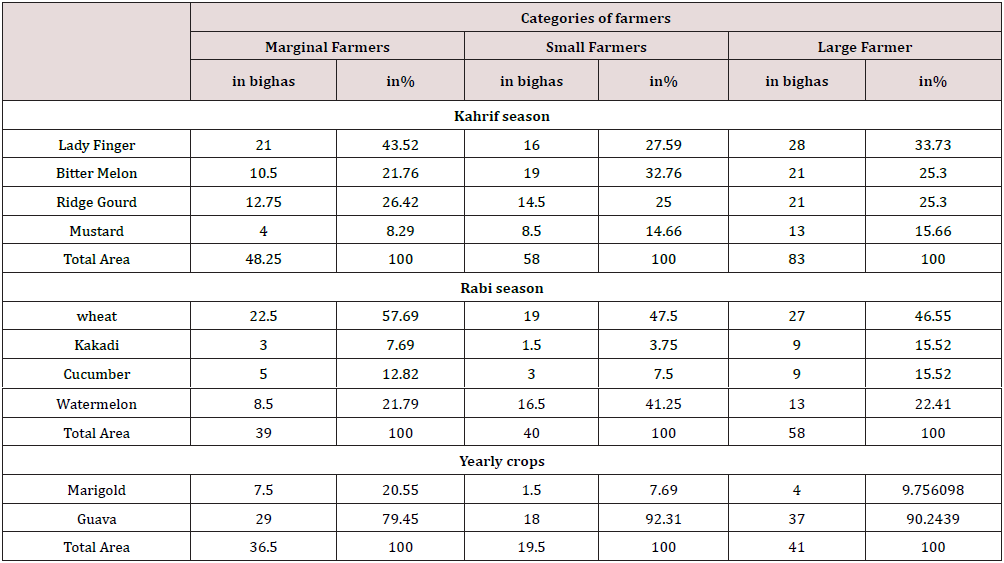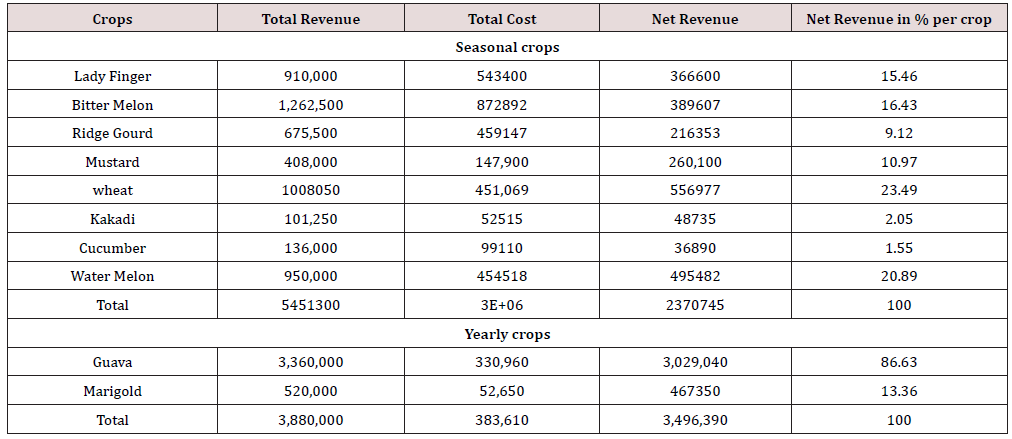
Lupine Publishers Group
Lupine Publishers
Menu
ISSN: 2641-6794
Review Article2641-6794 
Ganga River Resources and the Flow and Non-flow related Livelihood: A case study Uttar Pradesh in India Volume 3 - Issue 5
Panta Murali Prasad*
Department of Economic Sciences, Indian Institute of Technology Kanpur, India
Received:September 06, 2019; Published:September 19, 2019
Corresponding author:Panta Murali Prasad, Department of Economic Sciences, Indian Institute of Technology Kanpur, Kanpur, India
DOI: 10.32474/OAJESS.2019.03.000174
Abstract
Ganga river provides ecological (Biodiversity), social (Gangatva) and economic value (Livelihood) to the people of India. Economic agents exploit the river resources for their livelihood beyond natural regenerative and assimilative capacities. The State provided subsidies further motivate the agents to enhance their efforts to exploit the river resources for creation and accumulation of wealth. As a result, extinction of resources at a few stretches of the river in the State of Uttar Pradesh. The paper focuses on use values of flow (Ferry and Tourism) and non-flow (Riverbed Farming) livelihood in the State. Preliminary analysis of the study indicates that 80 Ghats at Varanasi consists of 193 boats have generated value of Rs. 55.26 million in eight months (i.e., October to May, 2010-11). Similarly, Pilgrims 170.30 million were visited at Mega Pilgrimage Sites (MPSs) namely Allahabad, Varanasi and Vindhyachal in Uttar Pradesh (UP) have generated a revenue Rs. 7,11,448.54 million during 2006-2010; and 286.25 bighas of Riverbed Farming generated profits of Rs. 5.9 million for 89 households in five villages of Kanpur District in 2010-2011. The inferences drawn based on the empirical study will be used to rationalize the advocacy to the economic agents to adopt judicious use of the gifted nature for Sustainable River related Livelihood.
Keywords:River resources; Livelihood; Riverbed farming; Ferry services; Tourism
Introduction
A large population living near the Ganga depends on river resources for their lives and livelihood. Similarly, the survival of the river depends up on the sustainable development practices. The Common Property Resources character of the river provides incentives to the individual economic agent to extract resources without concern for the sustainability of the river. As a consequence, river resources degrade and in turn limit availability of resources for livelihood. The study focuses on the economic value of river resources within a framework of flow and lean flow related livelihood to the people depending on the Ganga for their economic well being. It makes an argument for an efficient allocation and use of the river resources between ecological survival and the promotion of livelihood to those depending on the river Ganga.
The paper consists of four sections. Section- I write up is divided into four parts. Section-1 is on livelihood, Section-2 examines Ferry Services based livelihood, Tourism and River bed Farming, Section-3 makes Policy Suggestions and Section-4 is the conclusion.
Livelihoods an Overview
The Ganga River contributes to commercial and noncommercial activities during flow and lean flow seasons. The pristine river ecology will generate positive externalities. It is culturally rich river. The Hindus believes that the river water cure diseases and liberates from the cycle of rebirth. The holly water will be used in poojas (Sathyanarayan Vratam). The river resources also contribute to commercial activities. The relationship between the river resource and riverine peoples’ livelihood can be explained in the following Figure 1.
The above Figure 1 Ganga River Resources and the Livelihood indicates that she provides flow and non-flow resources for peoples’ welfare. Riverine people will enhance their efforts on exploitation of resources at economically sustainable yield, maximum sustainable yield and open access regimes. Science and technology development and State subsidies further reduces costs of efforts of the people. Accordingly, they have incentives to exploit river resources intensively. As a matter of fact, the health of river depends up on harvest efforts of riparian community and the wealth of riparian community will depends up on the health of the river. However, tragedy of commons, state provided subsidies, and myopic behavior among the community limits river resources sustainability which in turn will impact Biological, Physical and Human and Management systems across the river in India.
Livelihood Wise Analysis: Ferry Services, Tourism and Riverbed Farming
The river Ganga possess unique characteristics namely, International River, Interstate River, Gangatva, and promotes livelihood. The riparian community depends on river resources for their livelihood and the conservation of river resources which in turn depends on the community effort at (Economically Sustainable Yield, Maximum Sustainable Yield, Open Access with/without Subsidies) which they exploit the resources.
This study will endeavor to value the Ganga river resources on Ferry services in Vranasi, Tourism at Mega Pilgrimage Sites (MPSs) and Riverbed Farming in Kanpur District of Uttar Pradesh.
Ferry Services
Ferry services are used for carrying goods for trade, religious ceremonies and personal activities. The services were one of the best sources of income (Mahajanpad Yug, 500BC-100BC). A large number of ferrymen used to live in Varanasi with their primary occupation as providers of ferry services and fish harvest. Rajghat believed to be the oldest Ghat in Varanasi and was a major trading centre during the Maurya and Shung dynasty [1]. It also had trade relationships even with far-off countries viz., Greece and Rome during Kushan Empire (c. 2 BC – 3 AD), Babylon, ‘Suvarna Bhumi’ (Myanmar), Sri Lanka, etc. The argument has been strengthened by the coins found at the excavation of Rajghat (Vishwakarma, 1987). Ferry services, besides trade, also played a major role in festivals like, ‘Budhwa Mangal’ where special boats called ‘BAJRA’ were decorated and dancers performed on them witnessed by the King and rich people of the city.
Ganga River resources at Varanasi promote cultural activities. Hindus across the country are keen to perform cultural activities at Varanasi at least once in their lifetime. The supply and demand of the services depends upon the river related culturalism. Hence, the value of ferry services is a proxy to the value of the river resources. Secondary data on number of Ferry, Ghats, and Licensed Service Providers has been obtained from the Nagar Nigam, Varanasi. In order to assess the value of ferry services we have obtained information on: the category of Ferry services and the respective service charges, Ferry-wise number of trips per day, and employment. We have also developed a structured questionnaire to obtain the information from the selected respondents at selected Ghats. Varanasi has 80 old Ghats. A few more Ghats have been developed however are not of religious importance [2]. According to Hindu literature Assi Ghat was the last Ghat of Kashi. It is also believed that Kashi ends here because the Assi River meets Ganga at this point. There were 60 boats serving at this Ghat. The Dashaswamedh Ghat is also a historic and religiously the most important Ghat. Ganga Arti at this Ghat is popular. There were wooden cots all over the Ghat stairs for tourists to watch the Ganga Arti. There were only three ferrymen and the family jointly owned 24 boats. They are in this profession more than five generations. At Sheetla Ghat one family provides service with five boats. Prayaga and Rajendra Prasad Ghats are being developed by the government to use the tourists at the Dashaswamedh Ghat. Ferry license system provides access to the service providers to render their services at all the Ghats and permits number of tourists per ferry based on its capacity. The capacity of the ferry varies during the flood and lean flow seasons. The hotels at the Ghats also contribute to enhancement of ferry services by providing contract to the service providers for sightseeing in and around the Ghats. The ferry services at Varanasi and its economic value can be explained with the help of the following Table 1.
The table 1 indicates that 193 boats generate value of Rs. 55.26 million during October to May, 2010-11. It also reveals that the ferry services provide 49572man days. The Ferry personnel also extend their services to the Water Police in order to provide safety and security to the users of ferry services. According to the respondents, the ferry personnel usually receive 50 per cent of the total daily revenue as wages from their respective employers.
Tourism
The Kumbh Mela is celebrated in pilgrimage sites of Haridwar and Allahabad (River Ganga), and Nasik (River Godavari) and Ujjain (River Shipra). We have collected secondary data the Ministry of Tourism. The field survey in and around Haridwar and Rishikesh during 2009-2010 and its analysis has estimated the expenditure/ benefit per pilgrim per trip as Rs. 4,177.50. The analysis also estimated the economic value of the tourist visitation at the pilgrimage sites during 2006-2010 [3].
In the State of Uttar Pradesh, across the banks of the river Ganga there are eleven sites of pilgrimage. They are: Garhmukteshwar, Bijnor, Narora, Kannauj, Bithor, Kanpur, Allahabad, Mirzapur, Vindhyachal, Varanasi, and Gahamar. The Sites were visited by 187.43 million Pilgrims during 2006-2010. Our analysis focuses on three Mega Pilgrimage Sites (MPS) namely, Allahabad, Vindhyachal and Varnasi. The use values of the MPS can be illustrated in the following.
Figure 2(a)&(b): Use Value of the Ganga River Resources: Pilgrims and Revenue at the Mega Pilgrimage Sites in the State of Uttar Pradesh. Source of Data: Tourism Department, Government of Uttar Pradesh

The Figure 2 (a) & (b) indicates that the MPS in the State of UP namely, Allahabad, Vindhyachal (including Astabhuja) and Varanasi together have attracted 170.30 millions Pilgrims and have generated revenue of Rs. 7,11,448.54 millions during 2006-2010.
Pilgrimage at MPS in UP provides incentives to the economic agents to enhance economic activities by establishment of hotels, ferry services, and transportation. This in turn provide opportunities to suppliers of intermediary products namely, food grains. The direct and indirect activities of the economic agents induce other economic activities viz., Housing markets. Accordingly, the pilgrimage at MPS in UP promotes direct, indirect and induced livelihood which results in economic growth and development.
Riverbed Farming
Riverbed farming is a typical way of growing crops on the riverbed. River space is used for the riverbed farming to grow crops during lean-flow season. Soil health and sediments in the riverbed is rich and sufficient to cultivate vegetables, fruits, flowers, wheat, and rice.
Figure 3(a)&(b): Use Value of the Ganga River Resources: Pilgrims and Revenue at the Mega Pilgrimage Sites in the State of Uttar Pradesh. Source of Data: Tourism Department, Government of Uttar Pradesh

The riverbed farming areas (27) between Kanpur and Allahabad were analyzed with the help of Google Earth Satellite Images during 2001-2010. It was observed that the river space has changed from time to time. As a result, the riverbed areas are also changed in its size and shape. Moreover, a few of the riverbed farming areas were totally vanished. We focused on areas where the shape of river didn’t change, and moreover largescale riverbed farming is in practice for estimation of economic value. The areas of such nature have been identified nearby Bithoor Ruining temple and Ganga Bairaaj. This can be presented with the help the following satellite Figure 3a & b.
The pictures indicate that the riverbed farming areas near Bithoor includes Haingupur, Paingupur and Ramail Nagar villages. These villages are on the side of the river, Kanpur. The areas near Ganga Bairaaj include Devnipurva and Dharmkheda villages. These two villages are on the other side of the river, Unnao. However, they are part of Kanpur district.
In order to assess the user value of river resources in terms of riverbed farming we need to collect primary data on category of farmers, cropping pattern, cost of production, income during Kahrif and Rabi seasons and yearly crops. Information has been obtained from 89 households who are engaging in farming activities in the five villages of Kanpur District. Households were divided into three categories: Marginal (61), Small (18), Large (10) farmers [4]. The respondents are engaged in riverbed farming for more than 80 years. A few of the farmers are carrying out the farm activities on the riverbed for generations. The riverbed occupied by the respondents is 286.25 bighas. The main crops grown in the bed are lady finger, bitter melon, ridge gourd, mustard, watermelon, kekadi, cucumber, wheat, marigold and guava. The Farmers and Crop-wise allocation of the Riverbed for farming can be explained with the help of the following Table 2.
The table 2 shows that the cultivable area under Kahrif season is more than the Rabi season. It is because of some part of the cultivable bed will be inundated during floods. The total area owned by all the respondents’ accounts for 286.25 bighas (i.e., the sum of the areas under Kharif season and the yearly crops). Vegetables such as lady Finger, Bitter Melon and Ridge Gourd occupied larger part of the cultivable area in Kahrif season. In the case of Rabi season and the yearly crops it is Wheat and Guava occupied larger part of the cultivable area. Moreover, the size of the landholdings doesn’t influence the cropping pattern.
The cost of production and income varies among the seasons. We use C2 cost of production in order to estimate the cost of cultivation for different category of farmers. The farmers are not paying rent to the local self-government for the cultivable riverbed. Similarly, the price for the produced crops is available in the local market and is used for calculation of farm income. According to respondents, wheat is a capital-intensive crop and all other crops are Labour intensive. Moreover, wheat, guava and marigold are water intensive crops. It can be explained with the help of following table 3.
The table 3 reveals that wheat is a profitable crop for marginal and large farmers. In the case of small farmers watermelon generates highest profit. However, profit margin is larger in the case of yearly crop Guava to all categories of farmers. It is mainly because it covers larger part of cultivable area, the cost of production is low and is a flood resistant crop.
The Crop-Wise cost and revenue analysis will provide us insights on the profitable riverbed farming for the farmers. It will also provide information on economic value generated in 286.25 bighas of riverbed farming in the year 2010-2011. This can be explained with the help of the following table 4.
The table 4 indicates that the most lucrative crop is watermelon and wheat. However, the yearly crops guava and marigold brings more income than the total seasonal crops. The riverbed farming generates profits Rs. 5.9 million for 89 households in five villages of Kanpur District during 2010-2011.
Suggestions for Sustainable Ganga River Resources Amalgamated Livelihood
Economic value of riverbed farming at five villages in Kanpur district has provided insights about the size of the landholdings and cropping pattern, positive and negative externalities of the riverbed farming in Rabi and Kahrif seasons. The study indicates that 89 farmers have generated Rs.5.9 million by the riverbed farming activities. The river during the lean-flow season provides space which is used for riverbed farming. The rules of first cum first serve or might is right prevails in landholdings at riverbed space for farming activities. The farmers won’t pay rent to the local self-government in order to use the riverbed for farming activities. They use fertilizers and pesticides for growing vegetables, rice, etc. The intensive riverbed farming could be a threat to river space and ecological services. Thus, there is a need for establishment of River Zone Regulation to protect lean flow riverbed space. The riverbed space could be accessible for Sustainable Development farming. The formalization will help not only farmer (in case of crop damages due to floods) but generate revenue to government and preservation of riverine ecology.
Ferry services are in the nature of family occupation and provide services for transport goods, religious bathing, ashes immersion and tourism. However, various types of waste dumped in Ganga included natural call, fish market waste, postmortem waste, naladump, dhobi Ghat and people from neighboring area clean their utensils on the Ghat. Hence, the nirmal dhara and aviral dhara measures need to be adopted and effectively enforced in order to promote livelihoods and preserve ecosystem of the river.
Gagatva promotes Pilgrimage at Mega Pilgrimage Sites of UP. The Pilgrims concern to perform their spiritual and ritual activities irrespective of the nirmal dhara and aviral dhara. However, preservation of the river resources and conservation of Gangatva necessitates adopting measures towards formulation nirmal dhara and aviral dhara and establishment of efficient institutions to provide incentives to the users to enhance their efforts at Economically Efficient Yield/ Maximum Sustainable Yield for livelihood [5,6].
Conclusion
The Ganga River generates market and non-market resources. Economic agents’ continuous exploitation of the river resources, intensively, results in economic growth and development but critical depensation of species at certain stretches of the river. The demand for the river resources are on rise for livelihood. The river-human dependency is complex. Knowledge on understanding the river systems and the humans who depend on the systems is limited. In addition, plan for future river resources suggests assessment, forecasting and monitoring of availability, condition and use of the resources.
The study indicates that the flow related livelihood namely Ferry Services at the Ghats of Varanasi and Pilgrims at Mega Pilgrimage Sites in UP has generated a value of Rs. 7,11,503.80 million and Non-flow related livelihood viz., Riverbed Farming in five villages of Kanpur District has generated Rs. 5.9 million. The researcher has observed during the study that the availability of secondary data is limited. Moreover, collection of primary data requires a lot of resources. In addition, there is a need for acquire of local knowledge (localism approach) on complexity of river systems and the people who depends upon the river resources.
Extensive and intensive study on use and non-use values of environmental assets of Ganga River will generate knowledge on socio-economic benefits of the River Resources. The inferences drawn from the total value the river resources will further motivates to propose a study on examination of the cost of inefficient allocation (degradation) of river resources versus the value of the damage that the society suffers if the resources are not allocated efficiently. Moreover, the socio-economic-environmental studies will generate knowledge, develop methodology, curriculum and provide suggestions to policy makers to plan for future river resources. The studies will also create awareness among the communities on learning to living with river resources.
Acknowledgements
Author express special thanks to the Worldwide Fund – India (WWF), Ganga River Basin Management Plan (IITs Consortium) Ministry of Environment and Forest, Government of India. Thanks are also due to project associates at IITK and IITM. Special thanks to the students of Y6 and Y7 batches M.Sc. Economics Programme (ECO 341: Environmental Economics and Policy), and students of Environmental Engineering and Management Programme (ECO 747: Environmental Economics, Legislations and Social Impact) who have carried out field work as part of their academic assignments. We are grateful for the photocopy of Ganga paintings of Princep and books provided by Central Library of Banaras Hindu University and would also like to express our gratitude to Director, Kala Bhawan, BHU for providing books for reference work. This study would not have been completed without the cooperation of the ferrymen, Nagar Nigam of Varanasi and all those who directly or indirectly helped in the data collection of this study. We are extremely thankful to Mr. Pradip Nigam, Mr.Ram Khilawar and Mr. Ramakant who help us in our field survey and collection of data on River bed Farming.
References
- Motichandra (1984) Kashi Ka Itihas. Vishwavidyalaya Prakashan.
- Department of Tourism (Govt. of Uttar Pradesh) Tourism Statistics, Department of Tourism, Government of Uttar Pradesh, India.
- Panta MP (2014) E-Flows Related Livelihood in the Ganga River: A Case Study of Tourism. In: Sanghi R. (eds) Our National River Ganga. Springer XVI: 415.
- Hans RK, M Farooq, Suresh Babu G, Srivastava SP, Joshi PC, et al. (2000) Agricultural Produce in the Dry Bed of the River Ganga in Kanpur, India-A New Source of Pesticide Contamination in Human Diets. Industrial Toxicology Research Centre, Mahatma Gandhi Marg, Lucknow India 37(8): 847-852.
- Prasad PM (2012) “Livelihood” as part of the WWF-India and HSCB study on “Living Ganga Programme for E-Flows Assessment” in the Report on “Assessment of Environmental Flows for the Upper Ganga Basin” by the WWF-India Jay O Keeffe et al.
- Vishva karma IS (1987) Kashi ka Aitihasik Bhugol. Ramanand Vidyabhawan, New Delhi, India.

Top Editors
-

Mark E Smith
Bio chemistry
University of Texas Medical Branch, USA -

Lawrence A Presley
Department of Criminal Justice
Liberty University, USA -

Thomas W Miller
Department of Psychiatry
University of Kentucky, USA -

Gjumrakch Aliev
Department of Medicine
Gally International Biomedical Research & Consulting LLC, USA -

Christopher Bryant
Department of Urbanisation and Agricultural
Montreal university, USA -

Robert William Frare
Oral & Maxillofacial Pathology
New York University, USA -

Rudolph Modesto Navari
Gastroenterology and Hepatology
University of Alabama, UK -

Andrew Hague
Department of Medicine
Universities of Bradford, UK -

George Gregory Buttigieg
Maltese College of Obstetrics and Gynaecology, Europe -

Chen-Hsiung Yeh
Oncology
Circulogene Theranostics, England -
.png)
Emilio Bucio-Carrillo
Radiation Chemistry
National University of Mexico, USA -
.jpg)
Casey J Grenier
Analytical Chemistry
Wentworth Institute of Technology, USA -
Hany Atalah
Minimally Invasive Surgery
Mercer University school of Medicine, USA -

Abu-Hussein Muhamad
Pediatric Dentistry
University of Athens , Greece

The annual scholar awards from Lupine Publishers honor a selected number Read More...









